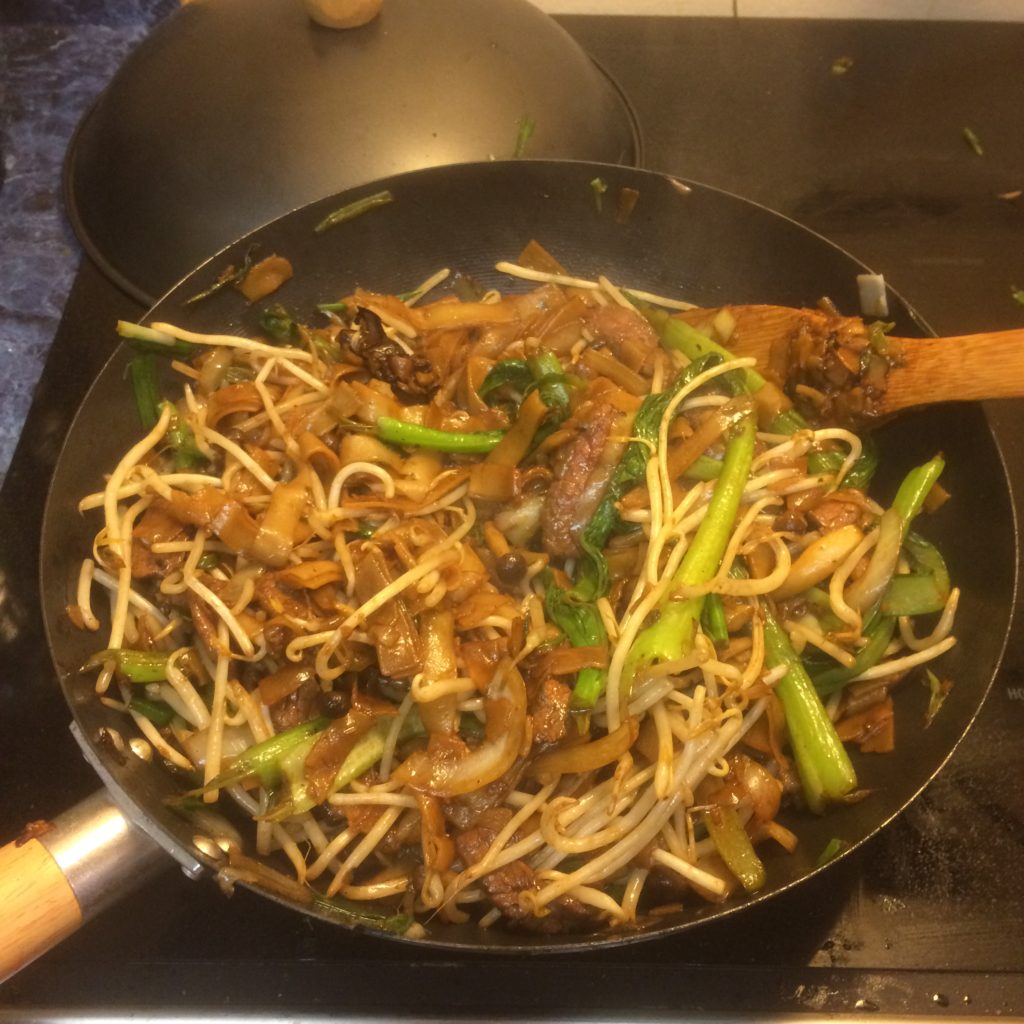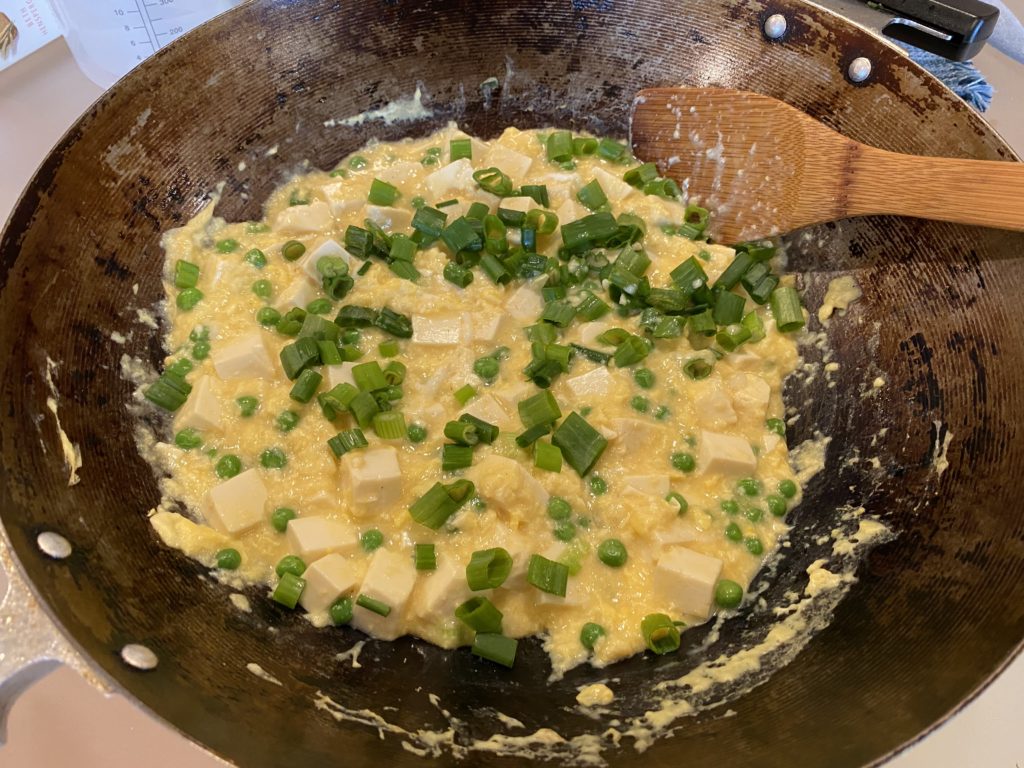By the time we moved out of our last place, I had come to terms with the electric stove. I just needed to set a five minute timer for my pans to pre-heat.
So when I moved into our current place about a year ago, I was very excited to get a gas cooktop. However, around the same time, I began to hear concerns about cooking with gas that made me re-think my enthusiasm.
Now we’re cooking with gas
Let’s start with the good times with the gas cooktop.
First, it heats up and cools down much faster than the electric stove. I only need to pre-heat a pan for one or two minutes before it’s ready.
When some starts to burn, I just need to turn down the heat. It sounds obvious, but on electric, there would be enough residual heat that I had to take the pan off the burner, or it would keep burning.
Second, I can actually cook with my wok. For years on electric, I thought I was using my wok wrong. I couldn’t get it to cook anything effectively, and it never seemed to be properly seasoned. Then, I put it on the gas stove, and the carbon steel instantly changed colors.
Even with a so-called “flat bottomed” wok, the cooking area on my electric stove was about a three-inch diameter where everything burned. Above that, the pan was basically cold.

With gas, the flames actually go up the sides of my wok and provide a useful heat gradient.

Unfortunately, as I read more, I had some concerns about the gas.
The other type of gas problems
These days, we have enough problems with outdoor air pollution from smog or forest fires. However, indoor air pollution is also a growing concern. Indoor air pollution can come from candles and aerosols, but the most common problem is from cooking.
Of course, the food itself creates indoor air pollution, both visibly in smoke and invisibly that we may detect by scent. That’s probably unavoidable and why we all should be cooking with hoods.
But the combusting gas itself also lets off other byproducts like nitrogen dioxide. And that is linked to higher rates of respiratory problems like asthma.
(For more, I’ll defer to this much better researched NPR story.)
Second, we’re moving away from using gas in our home to electrify everything instead. Not only is it good for carbon emissions, it’s much cheaper.
Of course, cooking doesn’t use nearly as much gas as indoor heating or water heating. As such, the other appliances are high priorities, but if we can save money in the long-run and have cleaner air for it, it would be nice to not need the gas hookup at all.
So I don’t want to go back to electric, but I don’t want to use gas, either. Fortunately there is an answer here.
An induction introduction
Like Harry Potter, I think induction cooking still sounds like something magical that they only do in Europe. However, it’s becoming more popular here presumably for the problems I cited above about electric and gas cooktops.
Induction cooking uses electricity but doesn’t do it the same way as electric cooktops. Electric cooktops run electricity through the heating element (think of one of those circular coils), and that gets hots and makes your pan hot.
Induction cooktops generate a magnetic field, and if you have the right pan (basically one that a magnet can stick to), then the current goes through the pan. The pan, however, as a big piece of metal generates some electrical resistance, which turns into heat.
It all sounds great, but the real question is whether I would like it or not to replace my gas cooktop.
The induction test drive
Apparently I’m not the only one wondering because my city government allows residents to try out loaner induction cooktops. And how might the local government facilitate short-term loans?
Through a common (but underutilized) service known as the public library.
I put a hold on a cooktop, like I would any book, and a few weeks ago, I got notice that the cooktop was ready. I dropped by the library and picked up a large backpack. When I got home, I had one of these.

It also came with some pans, some utensils, this cookbook, and a notebook to write about the induction experience.
I unfortunately forgot to take any pictures of what I made with the induction cooktop, but I did have some big takeaways.
We will start with the good news.
Upsides of induction
First, the induction cooktop is very responsive like gas: it heated up and cooled down quickly as I wanted. It also kept the pan at a very consistent temperature.
Second, it keeps the surface and kitchen much cooler overall. The cooktop still gets hot, but it’s not just radiating for awhile like other stoves. And especially nice during the summer, the kitchen otherwise stayed cool
Third, I was surprised that my big nonstick skillet worked with induction. I just assumed that my nonstick pans wouldn’t work, but it really does depend on the composition of the pan
Fourth, it feels really safe to use. When there isn’t a compatible pan on top of the cooktop, the induction just turns off. I’m not normally worried about electric or gas being unsafe. However, with a small child at home, it’s nice to know that things aren’t just randomly hot around.
The not so good
I will immediately disclaim that I’m not sure how many of these issues are specific to this countertop model or are general to induction.
First, even on maximum heat, the burner wasn’t very powerful. Maybe it’s an issue using a normal wall outlet, but when I tried to make chow fun in my wok, it wasn’t quite cooking with high heat.
Second, speaking of the wok, the cooking surface was again significantly diminished. I can’t quite recall how it compares to electric, but the heat wasn’t covering the sides as well.
That problem actually extended to my larger pans, too. I tried to make eggs using my big nonstick pan, and I was waiting for the edges to solidify. It was taking too long, so I flipped, and I realized that the eggs were overcooked in the middle, and the heat hadn’t quite reached to the edges.
Perhaps my pan was oversized for this induction cooktop, but that was disappointing.
Final Thoughts
I wish that induction was just a better experience than cooking with gas, but I’m not confident about that. Maybe induction really is better, but comparing this countertop model versus my built-in gas cooktop, I prefer my gas cooktop. In fact, by the end of the three week loan, I was mostly back on gas.
That being said, I still do plan to switch to an induction cooktop when that project comes up on the backlog. It’s still a cooking compromise, but the secondary benefits of electrification and reducing indoor air pollution are quite compelling.